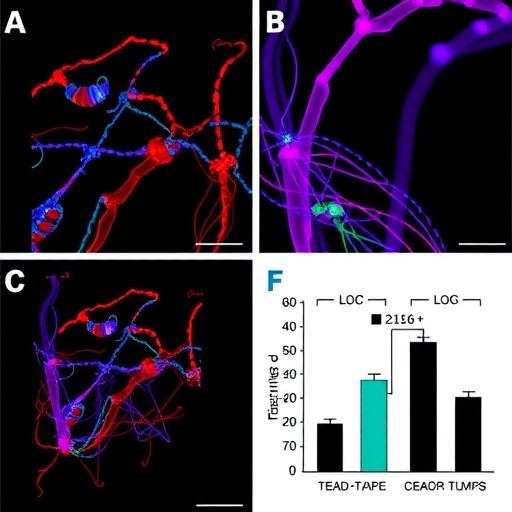In a groundbreaking advance in pulmonary medicine, researchers have uncovered a crucial signaling pathway that drives the progression of pulmonary fibrosis, a debilitating lung disease characterized by excessive scarring and tissue stiffening. This discovery opens up promising new avenues for therapeutic intervention and may significantly alter the clinical landscape for patients suffering from this life-threatening condition. The study, conducted by Wagner, Alsafadi, Mitash, and colleagues and recently published in Nature Communications, delves into the intricate molecular mechanisms by which epithelial cells contribute to fibrotic remodeling, highlighting the pivotal role of the YAP-TEAD/LOX axis.
Pulmonary fibrosis is a progressive disorder marked by the irreversible accumulation of extracellular matrix components, leading to diminished lung function and ultimately respiratory failure. Despite extensive research, effective treatments have remained elusive, partially due to the complex interplay of cellular and molecular players that orchestrate fibrotic processes. The researchers focused their attention on a subset of epithelial cells lining the lung alveoli, which have increasingly been recognized as active participants in disease pathogenesis rather than mere bystanders.
Central to the study is the transcriptional co-activator known as Yes-associated protein (YAP), which operates as a critical sensor of mechanical cues within the cellular microenvironment. YAP interacts with TEA domain transcription factors (TEADs) to regulate gene expression programs that govern cell proliferation, survival, and extracellular matrix production. The team hypothesized that aberrant activation of YAP-TEAD signaling in epithelial cells could be a driving force behind the fibrotic cascade.
Intriguingly, the study demonstrates that heightened YAP-TEAD activity induces the expression of lysyl oxidase (LOX), an enzyme responsible for cross-linking collagen fibers, thereby increasing tissue stiffness. The stiffened extracellular matrix further activates mechanotransduction pathways, resulting in a vicious cycle that exacerbates fibrosis. By establishing a direct link between epithelial YAP-TEAD signaling and LOX-mediated matrix remodeling, the authors provide a mechanistic framework that explains how epithelial cells contribute to pathological fibrosis.
To dissect the pathological significance of this signaling axis, the researchers employed a series of sophisticated preclinical models, including genetically engineered mice with conditional inactivation of YAP-TEAD components specifically in epithelial cells. These models revealed that deleting or pharmacologically inhibiting YAP-TEAD reduces LOX expression, attenuates collagen cross-linking, and markedly diminishes the extent of pulmonary fibrosis following lung injury. These findings underscore the therapeutic potential of targeting the epithelial YAP-TEAD/LOX pathway to halt or reverse fibrotic progression.
The team further augmented their analysis with single-cell RNA sequencing and spatial transcriptomics, techniques that allowed them to map cellular populations and gene expression patterns with unprecedented resolution. Their data pinpoint epithelial cells as the predominant source of YAP-driven LOX expression in fibrotic lungs, distinguishing them from mesenchymal cells, which have classically been viewed as primary ECM producers. This revelation challenges existing paradigms and expands the scope of potential cellular targets.
Another profound insight emerging from the study pertains to the regulatory feedback loops governing matrix stiffness and YAP activation. As extracellular matrix rigidity increases, YAP translocates to the nucleus more robustly, amplifying TEAD-mediated transcription. This biophysical interplay suggests that therapeutic interventions disrupting LOX activity or modifying matrix properties could indirectly mitigate YAP signaling, offering a multifaceted approach to functional restoration.
Importantly, the study also explored small-molecule inhibitors that disrupt YAP-TEAD interaction, such as verteporfin, demonstrating their efficacy in reducing fibrotic severity in vivo. These pharmacological agents recurrently suppressed LOX levels and collagen deposition, reinforcing the translational potential of targeting the YAP-TEAD interface. While verteporfin’s clinical applications have traditionally focused on ophthalmology, repurposing such compounds for fibrotic lung disease represents a compelling strategy.
In addition to experimental models, the researchers validated their findings in human lung tissue samples from patients with idiopathic pulmonary fibrosis (IPF). These analyses revealed strikingly elevated levels of YAP, TEAD targets, and LOX in diseased epithelia compared to healthy controls, confirming the clinical relevance of the molecular axis identified. By bridging animal and human data, the study solidifies a foundation for future clinical trials.
Delving deeper into the cellular microenvironment, the researchers uncovered that crosstalk between epithelial cells and fibroblasts is modulated by the YAP-TEAD/LOX pathway. Elevated LOX secretion alters fibroblast activation states, inducing a profibrotic phenotype characterized by enhanced matrix synthesis and contractility. This intercellular communication contributes to the relentless progression of fibrosis and highlights the complexity of cell-cell interactions orchestrating disease.
Mechanistically, the study illuminates how mechanical forces and biochemical signals converge in epithelial cells to maintain a pro-fibrotic niche. Integrin-mediated adhesion and cytoskeletal tension regulate YAP localization, while extracellular factors such as TGF-β potentiate transcriptional outputs. These layers of regulation underscore the adaptability of epithelial cells as central orchestrators of tissue remodeling, responding dynamically to their environment.
The trajectory of this research not only advances our understanding of pulmonary fibrosis but also heralds a paradigm shift in targeting epithelial signaling pathways. By focusing on the nucleus-centered relationship between YAP-TEAD and LOX, therapeutic approaches can be refined to intercept early pathogenic events rather than merely addressing downstream fibrosis.
Furthermore, the delineation of this pathway may have broader implications for other fibrotic diseases, including those affecting the liver, kidney, and heart, where epithelial or endothelial dysfunction plays a contributory role. The conservation of YAP-TEAD-mediated transcriptional programs hints at universal mechanisms of fibrosis, positioning this molecular axis as a nodal point for drug development.
As the scientific community eagerly anticipates translation of these findings, the authors advocate for further exploration into combinational therapies that integrate mechanical modulation, YAP-TEAD inhibition, and matrix-targeted treatments. Such multifactorial approaches may ultimately restore lung compliance and function, dramatically improving patient outcomes.
In summary, the discovery of the epithelial YAP-TEAD/LOX signaling pathway as a key driver of pulmonary fibrosis represents a landmark achievement, combining innovative molecular biology techniques with translational potential. It challenges longstanding dogma, redefines cellular contributors, and lays the groundwork for novel, targeted therapeutics aimed at one of the most vexing challenges in respiratory medicine.
Subject of Research: Pulmonary fibrosis and the molecular signaling pathways driving fibrosis in epithelial cells.
Article Title: Inhibition of epithelial cell YAP-TEAD/LOX signaling attenuates pulmonary fibrosis in preclinical models.
Article References:
Wagner, D.E., Alsafadi, H.N., Mitash, N. et al. Inhibition of epithelial cell YAP-TEAD/LOX signaling attenuates pulmonary fibrosis in preclinical models. Nat Commun 16, 7099 (2025). https://doi.org/10.1038/s41467-025-61795-x
Image Credits: AI Generated











